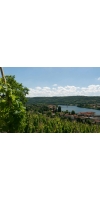Wine from Remi Niero

Remi Niero Estate
It is on terraced hillsides that the Domaine Niero harvests the best grapevines of Viognier and Syrah to offer unique vintages of Condrieu and Côte-Rôtie.
Culture ways:
Caring about environment, your wine grower has resorted to thoughtful working methods in the vineyard so as to develop a responsible wine growing . Moreover, aware of the need to adapt his culture policies, he has recently resorted to organic farming.
Date Founded: 1973
As vintage wines from the northern Rhône Valley, my vintages reflect our passion and are the fruits of a genuine know-how, a legacy from both my father and my grandfather. I invite you to discover the typical aspects of my wines, which I’ve worked on while keeping up the tradition and respect of our environment to make them the finest and the most unique vintages.
Either in Condrieu or in Côte-Rôtie, each type of vine (Viognier or Syrah) fully expresses itself according to its favourite soil. Endowed with a great open-mindedness further to my numerous visits through worldwide vineyards, I strive to make my wines delicate, structured and unique products. From the vineyard work to the wine-making process, my team and I have done our best to get the perfect maturity and the quintessence of aroma in order to offer the wines that wonderfully reflect our outstanding soil."
Rémi Niero
Condrieu and Côte-Rôtie wine grower
Now at the head of the vineyard , Rémi Niero has taken over from his father Robert, who, from Rémi’s early age, has passed on to him his whole know-how and passion for wine growing. The latter had taken over a small vineyard from his father-in-law Jean Pinchon in 1985, planting and working hard in those “chaillets” to make one of the most beautiful landscapes of our shared patrimony look more beautiful. Despite the requirement of this soil, his efforts have been rewarded by the authentic and natural balance of the wines.
To honor his masters Robert and Jean, Rémi offers his new vintage « Héritage» ,which is particularly faithful to the know-how and identity of the domain. Taken from the selection of the most beautiful casks of Condrieu, it will charm your taste buds and those of your guests.
Remi Niero Côte-Rôtie vineyard:
History:
It is one of the oldest vineyards in France. The Romans developed it and later, during the Middle-Age, a legend says that Lord Maugiron shared his good between his two daughters, one brown-haired and the other blond-haired,hence the names that the wines have kept , Côte Brune and Côte Blonde. Côte-Rôtie is the domain of the Syrah vine, which is broad and manly. A small place has been given to Viognier (20 % maximum allowed in the blend) which can bring a more feminine note.
Soils and climate:
The vine is harvested on grape-pickers’ backs on very steep granitic hillsides called “chaillets”, hold back by stone walls. The climate is the same than in the Condrieu vineyard. Rémi and Robert Niero’s Côte-Rôtie comes from two parcels over two hectares : La Viallière and Le Côteau de Bassenon (the southernmost parcel of the label).
No products found
- back
Selected Options
Wineries
Categories
Pricing
Countries
Regions
Grape Types
Wineries
Organic/Free Shipping
Hall Wines The Kathryn Hall Cabernet Sauvignon is made from 96% Cabernet, 4% Merlot.
The 2017 Kathryn Hall is deep, dark ruby in color and elegantly balanced with layered aromas of concentrated blackberry, freshly turned earth, and a hint of warm, spicy oak. The palate is fruit-forward with underlying notes of rich cocoa and leather. Layers of black fruit, nutmeg, cassis and brooding earthy notes are abundant. Supple, seamless tannin abounds, and the wine finishes with an incredible dark fruit feed-back that lasts several minutes.
Review:
The 2019 Cabernet Sauvignon Kathryn Hall is a blend of 95% Cabernet Sauvignon and 5% Merlot, brought up mostly in new barrels. It’s a killer bottle of wine offering lots of ripe black fruits intermixed with savory herbs, melted chocolate, and tobacco. Medium to full-bodied on the palate, it shows the lush, round, velvety style of the 2019 vintage and is already impossible to resist. It’s going to evolve for 15+ years if well stored.
-Jeb Dunnuck 95 Points
Clos des Cazaux Gigondas Le Souiras is 100% Grenache.
“Le Souiras” is the terroir located at the very South end of the Gigondas appellation. Here, in the midst of the Dentelles de Montmirail, an extraordinary calcareous massif, we planted grapevines on slopes surrounded by Mediterranean vegetation.
We are situated at an altitude of 250 meters, where the nights are cooler. The terroir is stony with a layer of grey and blue clay under the topsoil. The slopes face West and are protected from the strong summer sun by the Montmirail hill. Due to this ideal microclimate, our old Grenache grapevines contain all the complexity and balance of this sunny terroir.
Color : Dark intense ruby color.
Bouquet : Notes of little red fruits, white pepper, caramel and juniper.
Palate : The first impression is arresting and generally qualified as round, complex and dense.
The aromas of black cherry, mocha and white pepper are very intense. The palate is powerful, elegant and velvety.
The finish is long, with very silky tannins and a very slight bitterness that gives this exceptional Grenache an impression of freshness.
Review:
"A brilliant wine that has so much to love, the 2022 Gigondas Le Souiras is all Grenache that was brought up in barrels. It exhibits a vivid ruby hue as well as classic kirsch and blackberry fruit intermixed with peppery garrigue, spice, and ample Provençal nuances. This medium-bodied, fresh, focused 2022 has a beautiful sense of elegance, fine tannins, and the balance to evolve gracefully over the coming 10-12 years."
- Jeb Dunnuck (December 5th 2024), 94 pts




